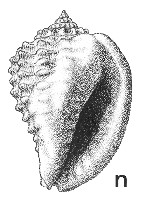
Revised descriptions of New Zealand Cenozoic Mollusca from Beu and Maxwell (1990)

 | Revised descriptions of New Zealand Cenozoic Mollusca from Beu and Maxwell (1990) | 
|
  (Pl. 25n): topotype, left bank Waiau River, Clifden, Lillburnian (Canterbury Museum) |
Beu & Maxwell (1990): Chapter 11; p. 231; pl. 25 n.
Synonymy: Oniscidia finlayi Laws 1932, p. 188
Classification: Harpidae: Moruminae
Description: Size moderate for genus (height 40-46 mm), oval, spire very low, about 0.1 total height. Protoconch conical, of about 3.5 smooth, convex whorls. Teleoconch of 5- 5.5 whorls, strongly shouldered at or above middle on spire with strongly concave sutural ramp; last whorl large, enveloping, inflated posteriorly, neck short and broad. Axial sculpture of very prominent, raised, rounded costae with much broader interspaces, reaching from suture to suture on early whorls but subobsolete to obsolete on sutural ramp on later whorls; 8-11 costae (and terminal varix) on last whorl. Spiral sculpture of wide, raised, rounded, widely spaced cords, 2 on penultimate whorl, 10-12 on last whorl, crossed by many, closely spaced, high axial lamellae. Aperture long and narrow, parallel-sided; siphonal canal short, straight, moderately notched; fasciole very low. Inner lip thickly callused, spread smoothly over much of apertural face of last whorl, with a few weak nodules and ridges over inner columellar area, very variable in development. Outer lip very strongly thickened and flared to form heavy, rounded terminal varix, bearing 8-10 low nodules on inner edge.
Comparison: Specimens of Morum (Oniscidia) from Pakaurangi Point, Kaipara Harbour, Northland (Otaian-Altonian) have a shorter spire and have the axial costae more compressed posteriorly than South Island shells, but are otherwise very similar to typical M. finlayi. A similar but smaller, narrower species with a more obvious, twisted fasciole is M. harpaforme (Otaian, Oneroa, Waiheke Island; Kawau Island). A larger, unnamed species occurs in the Wharekuri Greensand, Waitaki Valley (Duntroonian); its spiral cords are much lower and less distinct than in M. finlayi. The genus was therefore well represented in New Zealand during warm-water periods of the Oligocene and Miocene. Beu (1976b) pointed out that M. finlayi may have been ancestral to the living southwest Pacific M. bruuni (Powell, 1958) (Kermadec Islands, New South Wales and, very rarely, northern New Zealand) which differs only in its much weaker spiral cords.
Morum finlayi is an interesting and attractive member of a tropical and subtropical genus, widely distributed on soft substrates of the inner to middle shelf zone, in Indo-West Pacific, eastern Pacific and Caribbean seas. Morum was for a long time thought to be a cassid (i.e., in family Cassidae, Littorinimorpha), but studies of the anatomy of M. tuberculosum (Reeve, 1842) showed that it should be transferred to the neogastropod family Harpidae (Hughes 1986). As the name chosen by Powell and Bartrum (1929, p . 428) for their species suggests, some species of Morum — particularly in the subgenus Oniscidia — are not unlike more typical species of Harpa in shell characters.
Distribution: Otaian-Lillburnian; North bank, Waiau River, Clifden, "bed C" (= Third Bay Sandstone), Lillburnian (type); Calamity Point Sandstone and Long Beach Shellbed, Clifden; Mount Brown Formation, Weka Creek, North Canterbury; Upper Waipara River, North Canterbury; Stillwater Mudstone, Lake Ryan, Greymouth. Uncommon at all localities.
Cite this publication as: "A.G. Beu and J.I. Raine (2009). Revised
descriptions of New Zealand Cenozoic Mollusca from Beu and Maxwell (1990). GNS
Science miscellaneous series no. 27."
© GNS Science, 2009
ISBN
978-0-478-19705-1
ISSN 1177-2441
(Included with a PDF facsimile file
copy of New Zealand Geological Survey Paleontological Bulletin 58 in CD version
from: Publications Officer, GNS Science, P.O. Box 30368 Lower Hutt, New
Zealand)